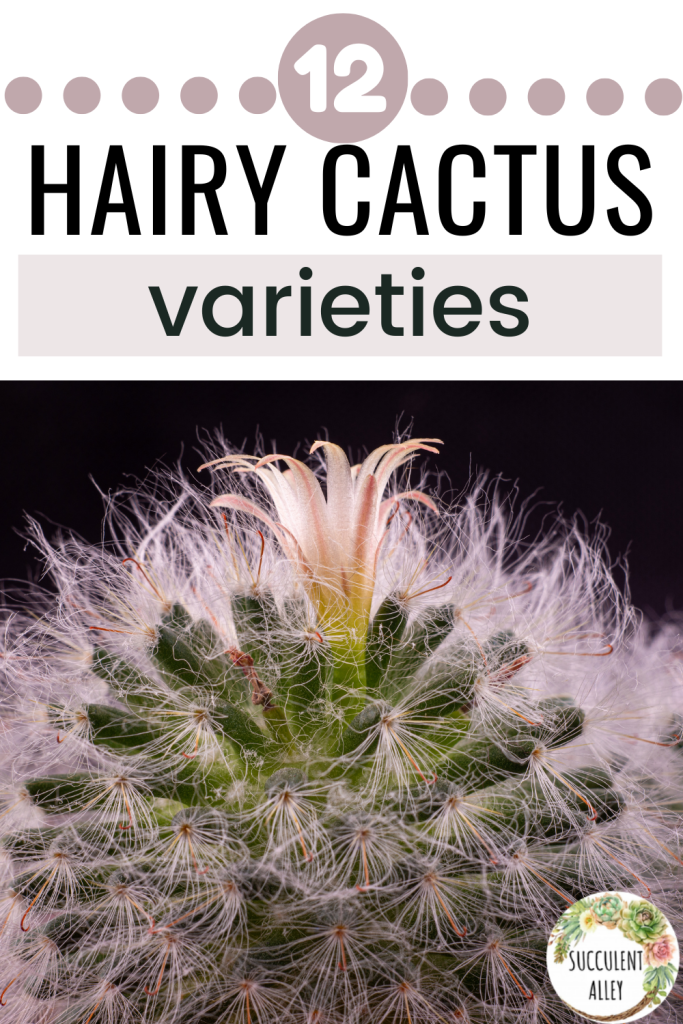12 Little-known Hairy Cactus Types With Pictures
A cactus is a member of the plant family Cactaceae. Like all Cactaceae, they store water to survive in drought conditions and very hot environments and tend to generate spines to defend their water deposits.
However, the common points of these plants end there. There are a lot of varieties of cacti, and their characteristics can vary greatly. There are even cactus with hairs! Join us in this article to learn more about some hairy cactus types, their names, and care.
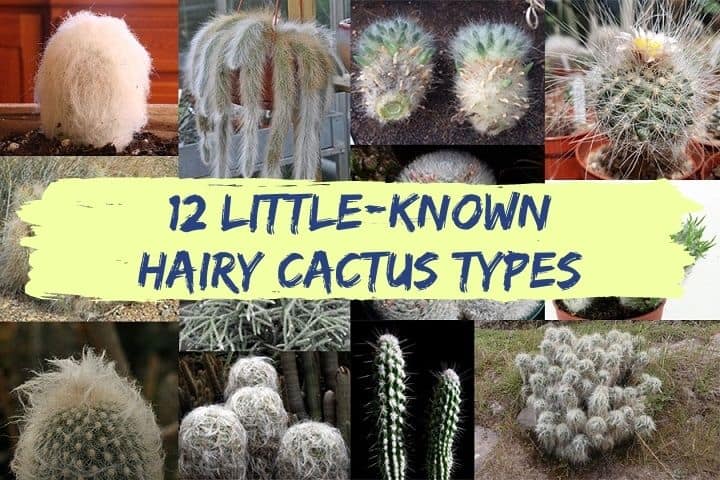
Related Post:
1000 Types of Cacti With Pictures and Names
Contents
- 1 Hairy Cactus Types
- 1.1 Old Man Cactus (Cephalocereus senilis)
- 1.2 Peruvian Old Man Cactus (Espostoa lanata)
- 1.3 Powder Puff Cactus (Mammillaria bocasana)
- 1.4 Austrocylindropuntia lagopus
- 1.5 Monkey’s Tail (Cleistocactus winteri subs. colademononis)
- 1.6 Eulychnia saint-pieana
- 1.7 Grizzly Bear Prickly Pear (Opuntia polyacantha var. erinacea)
- 1.8 Austrocylindropuntia floccosa
- 1.9 Old Man of the Andes (Oreocereus celsianus)
- 1.10 Pediocactus paradinei
- 1.11 Hairy Stemmed Rhipsalis (Rhipsalis pilocarpa)
- 1.12 Old Man Opuntia (Opuntia vestita)
Hairy Cactus Types
Some species of cacti have small hairs that occur in different forms depending on the species—short, long, very soft or a little harder. The hairs are more or less delicate plant organs, which can perform various functions in plants.
Like the wax of many succulent leaves, the hairs of some cacti are part of their adaptation to the environment and their functions are varied and even contraposed. These include avoiding plant water loss or being able to capture dew water, insect protection, or perhaps protection against over-exposure to light or adverse weather conditions.
Below are some fuzzy cactus types:
Old Man Cactus (Cephalocereus senilis)
The old man cactus is one of the most popular types of hairy cactus. As the name implies, it has grayish-white, distinctive, long, wooly hairs that look like the beard of an old man.
This white fuzzy cactus is a columnar cactus that can sometimes branch and reach 1 meter in height (in nature they reach 15 meters). The most interesting thing about these plants is their curious thorns in the form of gray hairs that protect them from the cold. Although in pots they do not usually bloom, if they do they produce large white flowers that open at night in mid-spring and early summer.
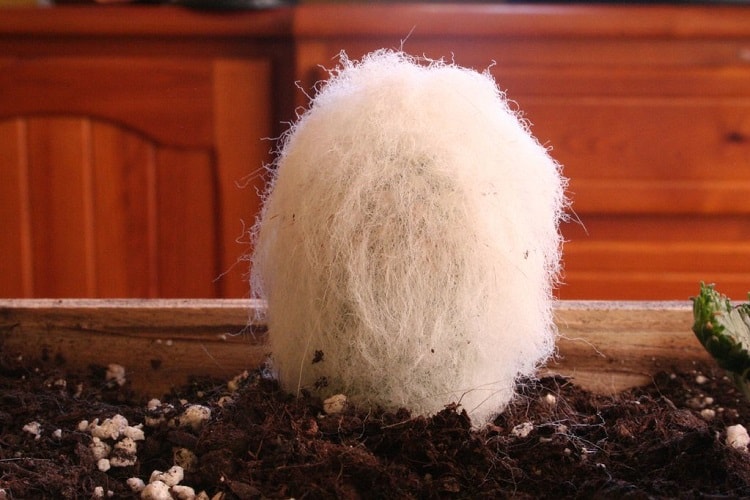
The old man cactus is a slow-growing cactus that is used to create mini gardens along with other cacti. They are also interesting in individual pots.
These plants need a very sunny exposure to develop their “mane” well. Young plants do not withstand less than 10 °C but adult plants can withstand up to 6-7 °C. The soil could be a mixture of 1/2 coarse sand and another 1/2 of leaf mulch. It is advisable to put gravel on the surface so as not to accumulate moisture.
Water very moderately and never wet the plant directly. If you want to increase the growth of “white hair” you can provide lime-rich mineral fertilizer in spring and summer.
Peruvian Old Man Cactus (Espostoa lanata)
Another fuzzy cactus plant, the Espostoa lanata is a cactus of American origin, more precisely from the desert areas of Ecuador, Peru, and even Bolivia. It is a columnar cactus that can reach several meters in height. It is also known as the Peruvian Snowball Cactus, Woolly Cactus, and Peruvian Old Man Cactus. Its name derives from its general appearance, hairy or woolly, being covered by long bristles that surround it and give it that woolly appearance. It can grow between 800 and 2,000 meters of altitude.
It is a slow-growing, tree-shaped cactus that branches off at the top over the years. It reaches from 2 to 5 meters in height in adult specimens. The stems are cylindrical, erect with a trunk 6 to 12 cm in diameter. The stems are 12-20 cm in diameter.
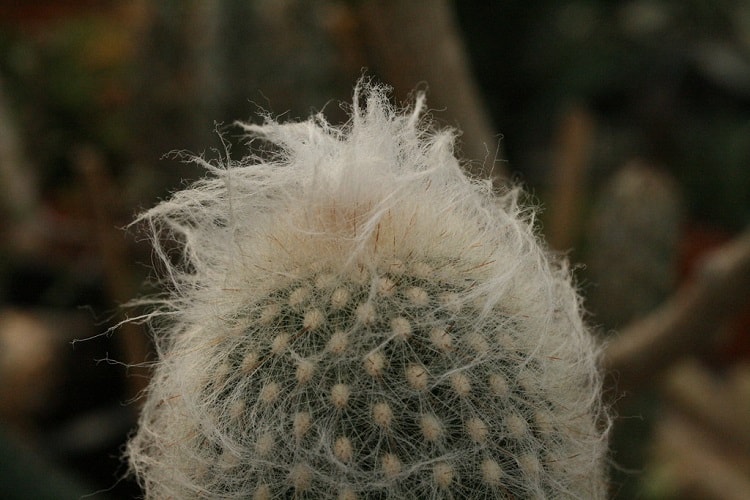
Beneath the bristles or hairs, lie hidden sharp spines. So beware, or you will be pricked.
The Peruvian Old Man Cactus needs full sun or direct sun exposure, although it also works well in semi-shade. This fuzzy white cactus supports high temperatures well. It does not tolerate excessive humidity, so reduce watering progressively in the fall, and avoid watering in winter. In warm areas, you have to water occasionally in winter as long as it doesn’t rain.
Fertilize weekly in the watering season, with a mineral fertilizer, especially in flowering. It does not need much fertilizer, being of medium nutritional needs.
Powder Puff Cactus (Mammillaria bocasana)
Mammillaria bocasana is a clumping cactus, often forming large mounds. It is commonly referred to as the “Powder Puff Cactus” and the “Snowball Cactus” due to its resemblance to a cactus with a cotton-like appearance, characterized by silky white hairs covering the small round plant. This fuzzy cactus plant is quite variable with a lot of different varieties and forms available in cultivation. Generations of cactophiles have had this plant as one of their first acquisitions and few can have been disappointed by its easy cultivation and free-flowering habit.
Its origins can be traced back to Northern central Mexico, especially in San Luis Potosi Zacatecas and Queretaro states, Mexico. It grows among volcanic rock on canyon walls and at the foot of a hill in semi-desert. It is a fast-growing cactus covered with clusters of silky white hairs, with each cluster surrounding a yellow-to-red hooked spine. The spines are used to make fishhooks in Mexico.
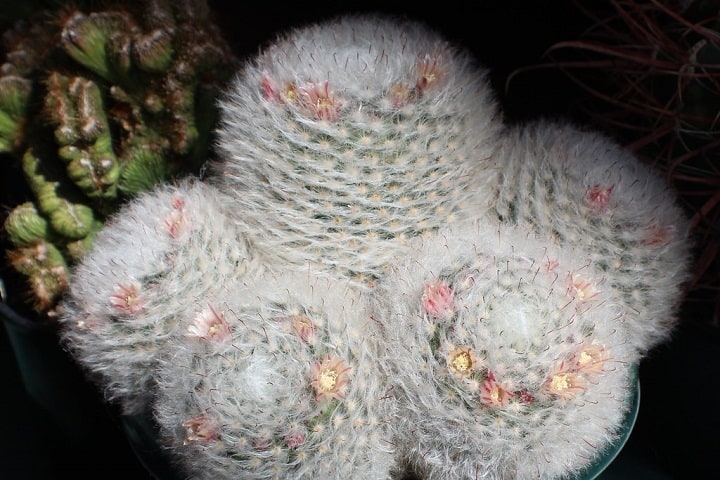
Mammillaria bocasana is a freely clustering species that reproduces easily by cutting. It is a great starter plant for the cactus grower, that readily builds up into a dense cluster of stems smothered by white hairs, further decorated by rings of cream or pale pink blooms. It is a rapidly growing species. It offsets from the base and can fill a 25 cm pot in just a few years given the best conditions.
It is quite frost resistant if kept dry, hardy as low as -5°C (some reports give it hardy to -12°C). However, some warmth throughout the year will increase the grower’s success (minimum 5° to 8°C during the rest season).
Several cultivars of the Mammillaria bocasana exist, with varying quantities of wool, and flower colors. The plants sold as ‘forma multilanata’ are very woolly, with yellowish flowers.
Austrocylindropuntia lagopus
Austrocylindropuntia lagopus is a low-growing cactus species forming very dense, large cushions to several meters in diameter and a height of 60 cm. From the areoles arise very fine, up to 2 centimeters long, creamy-yellowish hair. The epithet “lagopus” comes from the Greek “lagôs”: hare and “pous”: foot about the narrow stems covered with thick white wool, evoking the leg of a snowshoe hare (Lepus americanus).
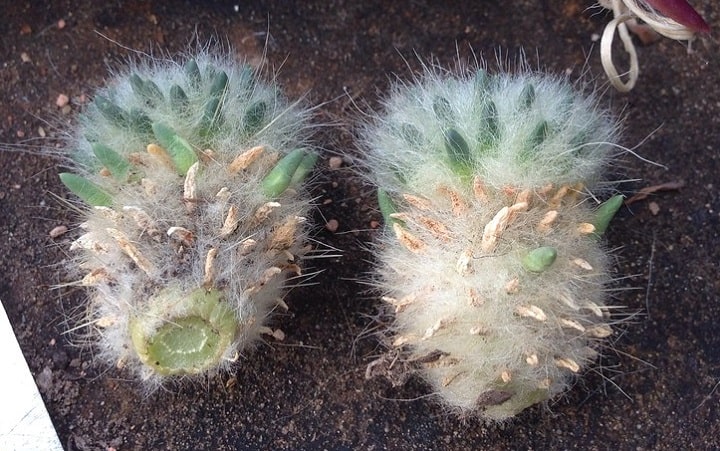
The stems are so densely hairy and concealed that probably do not have any photosynthesis role, which is indeed supported by the leaves. In habitat, the leaves are almost entirely hidden in the hair, but usually noticeably exerted above the hairs in cultivation.
It is quite winter hardy and can be cultivated outdoors if adequately protected from the rain and kept perfectly dry. It is prone to rot and needs good drainage, so water sparingly. It also needs as much direct sunlight as possible to encourage the heaviest spines and wool formation. Plants in shaded positions grow etiolated and fail to produce the typical hairy covering. They need to be kept in a cool place during the winter rest (at 0 to -10°C) this is important for the flowers as well as for their health.
Seeds are seldom available and extremely difficult to germinate, so it is best propagated by cutting that frequently doesn’t succeed in producing roots or roots very slowly and unpredictably. For this reason, this plant is often grafted.
Monkey’s Tail (Cleistocactus winteri subs. colademononis)
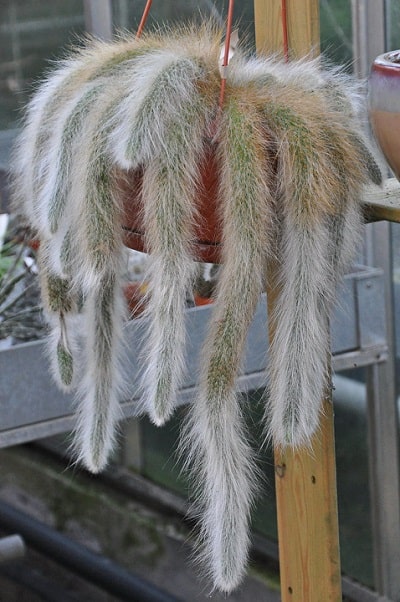
Cleistocactus winteri subs. colademononis, sometimes listed under its old name of Hildewintera colademononis, is a fantastic plant with very long white and soft, hairlike spines. The common name “monkey’s tail” refers to the appearance of the hairy stems. It is free flowering and the outsize bright red blooms are particularly decorative.
Cleistocactus winteri subs. colademononis is of easy culture, which makes it a good cactus for beginners. It is suited to hanging baskets as well as pots. Since they are rapid growers and need plenty of space for their roots, repotting with fresh potting mix should be done every other year or when the plant has outgrown its pot. However, repotting doesn’t necessarily mean they’ll need larger containers.
The monkey’s tail cactus requires filtered bright light, partial sun or light shade, but not full sun that will sunburn it. It requires moderate watering throughout the growth season. This can be done weekly or more frequently during the summertime if the weather is sunny enough, but allow it to dry fully before watering again. Kept this way, the plants will show healthy growth. Keep rather dry as soon as the temperature starts dropping in October and keep it dry in winter. The plant survives outside without protection in winter (cold hardy to -2°C) but is then somewhat prone to rot, too.
They are easy to propagate from cuttings or seeds.
Eulychnia saint-pieana
The popular Eulychnia saint-pieana is a morphological form of Eulychnia breviflora, very priced for its especially hairy areoles, but both plants with scarcely woolly areoles and plants with very woolly areole (with all intermediate forms) are found throughout the distribution range of the species and it is difficult to classify Eulychnia saint-pieana as a separate variety.
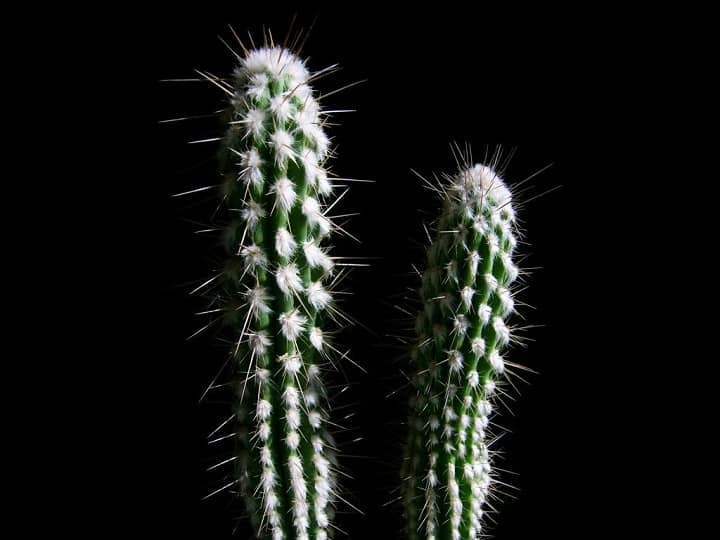
It is one of the showiest Eulychnia species sought-after by cacti impassioned, producing lots of short white wool as a bed for those long spines. It’s a must for any columnar collector!
Grow them in rich, porous, sandy soil, and let their soil dry out between waterings. If potted, repot in the spring, if their roots become cramped. Generally, they should be repotted every other year to provide fresh soil. However, this doesn’t necessarily mean they’ll need larger containers. Fill about a quarter of the pot with broken crocks, gravel, etc. to promote good drainage. After repotting, do not water for a week or more.
This plant is easily grown on its roots. It can be increased by cuttings, which will take root at a minimum temperature of 20°C.
Grizzly Bear Prickly Pear (Opuntia polyacantha var. erinacea)
Grizzly bear Cactus (Opuntia polyacantha var. erinacea) is a low-growing cactus with broad, thin stem segments (pads). The pads are medium-sized for a prickly pear (about 5 inches long by 3 inches wide). The spines are sparse to dense, short to long (to 6 inches, wavy, and flowing). The long, flowing spines sometimes completely obscure the pads.
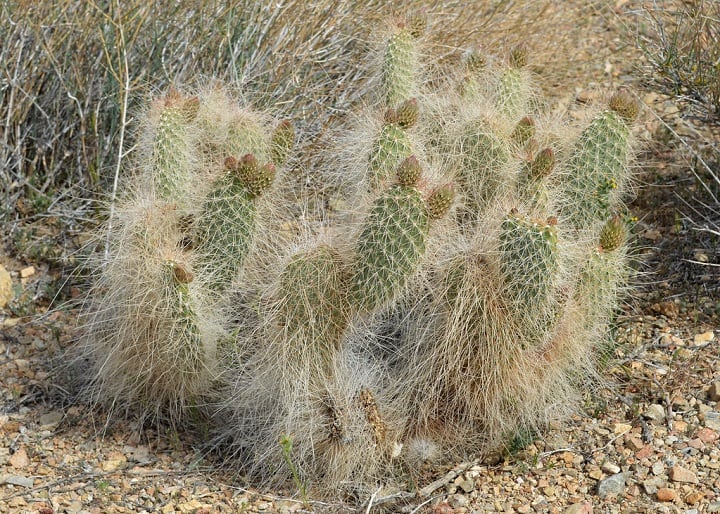
Grizzly bear Cactus is a locally common (uncommon overall, but can be abundant in certain areas) component of vegetation communities on well-drained sandy, gravelly, and rocky soils along washes, canyons, and on upper bajadas and moderate slopes into the lower mountains in the Upper Sonoran (Mojave Desert Scrub and Pinyon-Juniper Woodland) life zone.
Around Las Vegas, this cactus is found at middle elevations in the mountains, making it difficult to find without a hike. A few can be found near Willow Springs at Red Rock Canyon NCA (Petroglyph Wall Trail), and the Visitor Center on Mt. Charleston.
Flowers are colored rose-pink or yellow, leading onto spiny fruits. It has a clumping habit and is hardy to -20 °C if kept dry over the winter. Plant in a position of full sun, in well-draining soil for optimal growth.
Austrocylindropuntia floccosa
Austrocylindropuntia floccosa, also called waraqu is a groundcover cactus that forms thousand-head colonies or compact cushions of up to 60 (and over) cm in diameter. This plant is covered with a dense, long-woolly felt of white hair and yellow spines from which emerge bright yellow flowers.
This white fuzzy cactus grows on the high puna region in dry valleys, rocky slopes among grasses, and low bushes in high-elevation tropical alpine habitats. Only here and there the brown colour of the grasses is interrupted by the white colour of the big cushions of the “wool cactus,” Austrocylindropuntia floccosa. From the distance, the plants look like recumbent sheep. The Puna region has a marked dry season and overnight temperatures that drop often below 0°C (to -15°C).
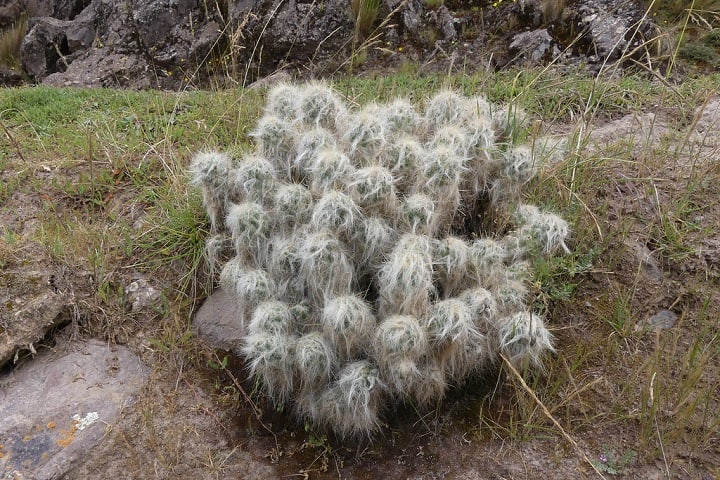
The typical form of Austrocylindropuntia floccosa in central Peru has a dense covering of long hairs that protect from freezing temperatures and from high-altitude ultraviolet light, comparisons in habitat with ‘hairless’ forms showed that the hairy type maintains an epidermal temperature several degrees higher during the night. Austrocylindropuntia floccosa may be found in nature with its roots in snow-water-logged conditions.
This hairy cactus needs as much direct sunlight as possible to encourage the heaviest spines and wool formation. Plants in shaded positions grow etiolated and fail to produce the typical hairy covering. It is quite winter hardy and can be cultivated outdoors if adequately protected from the rain and kept dry.
Old Man of the Andes (Oreocereus celsianus)
Oreocereus celsianus, or the “old man of the Andes” is a columnar cactus growing in clumps that, in the wild, may reach and exceed 3 m of height (but usually less than 2 m tall). It is difficult to see the shape of the ribbed stem, as it is thickly clothed with silky white hairs.
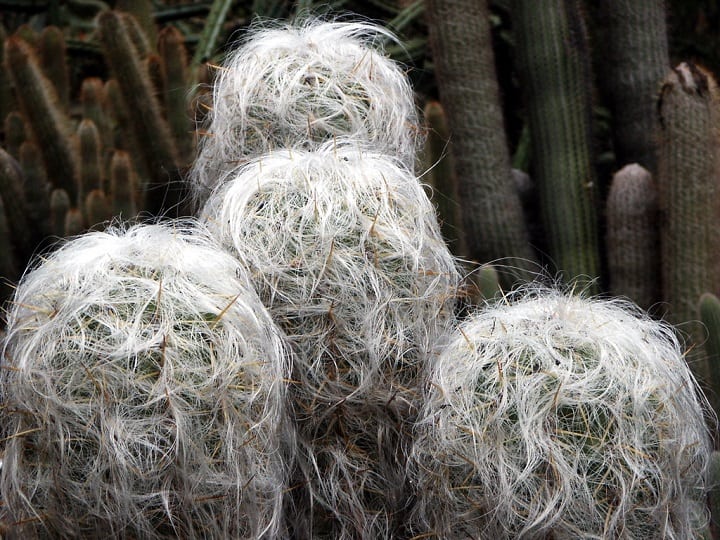
Oreocereus celsianus is widely spread at high altitudes in Argentina, Bolivia, and Peru. This fuzzy white cactus is common and abundant. It occurs naturally in the semi-arid Andean region in sheltered sites on rocky, well-drained soils among high mountains, mostly in slopes with orientation to the east and north. It flourishes in areas characterized by a cold and dry climate in winter and warm with rare rainfalls in summer.
It is believed that the white hairs provide protection from the intense ultraviolet light of the higher altitudes and are also equipped with “antifreeze chemicals” in their sap that make it somewhat frost resistant. It needs full sun exposure with ample airflow to produce dense hairs, but, as a former mountain dweller, does not care for extremely high temperatures in summer.
Pediocactus paradinei
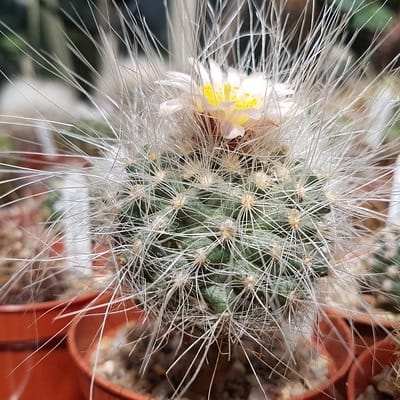
Pediocactus paradinei is a pretty, small, grey-green globose plant. It is also known as the Park Pincushion Cactus, Paradine Cactus, Kaibab Pincushion Cactus, Houserock Valley Cactus, and Bristly Plains Cactus. Its natural habitat is the East side of the Kaibab Plateau and the west edge of House Rock Valley, (Coconino County; northern Arizona, USA). Pediocactus paradinei is scarce and occurs in small and scattered patches.
The “hair-like” spine is not always a “typical” characteristic of Pediocactus paradinei; however, in the habitat, there are few plants with such long white hair. There are other types of hairy cactus very similar to Pediocactus paradinei. They are extremely variable in spination.
They are some of the most difficult cacti to grow from their own roots, cultivated only by expert cactus enthusiasts. Nevertheless, plants on their own roots are very hardy. They don’t tolerate living in a humid and heated greenhouse. Place them in a ventilated position; they like “wind”. Avoid direct sunlight exposure in summer. Water moderately only from early March to May; the rest of the year keeps them in dormancy. They are exceptionally slow growers. They may need 7 to 10 years to grow into mature specimens with long hairy spines. For this reason, it is frequently grafted on strong hardy cactus stock like Opuntia and Echinocereus.
Hairy Stemmed Rhipsalis (Rhipsalis pilocarpa)
Rhipsalis pilocarpa is a particularly attractive tropical epiphytic (rarely lithophyte) plant from Brazil with long hairy, cylindrical stems and white, very fragrant, flowers about 2 cm in diameter. The plant forms pendent bushes and is quite variable.
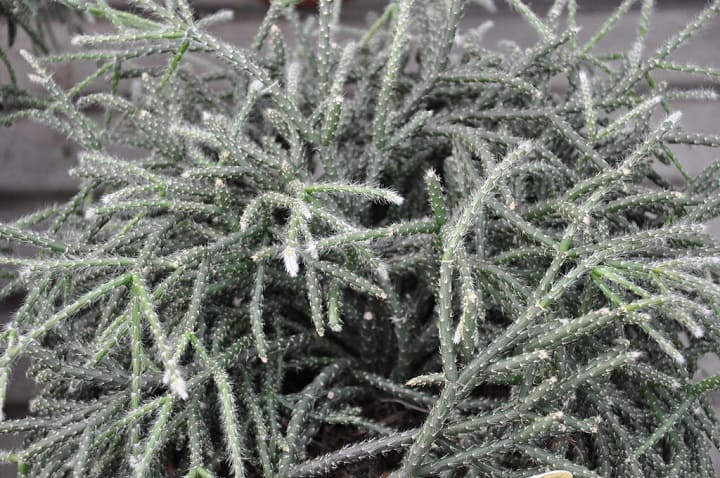
Rhipsalis pilocarpa is among the easiest to cultivate epiphytic cacti and tolerates neglect. These cacti won’t want normal cactus soil but will prefer to be in a soil largely composed of organic material, such as peat or sphagnum moss, This type of soil would normally be used for orchids, bromeliads, or other epiphytic plants. These forest cacti tend to be long-lived.
Old Man Opuntia (Opuntia vestita)
Opuntia vestita is usually a slender columnar white and very furry cactus from high altitude. The standard plants form branches both basally and near the top of the stems. It occurs in Argentina in Jujuy and Salta, and in Bolivia in Cochabamba, Chuquisaca, La Paz, Potosi, and Tarija.
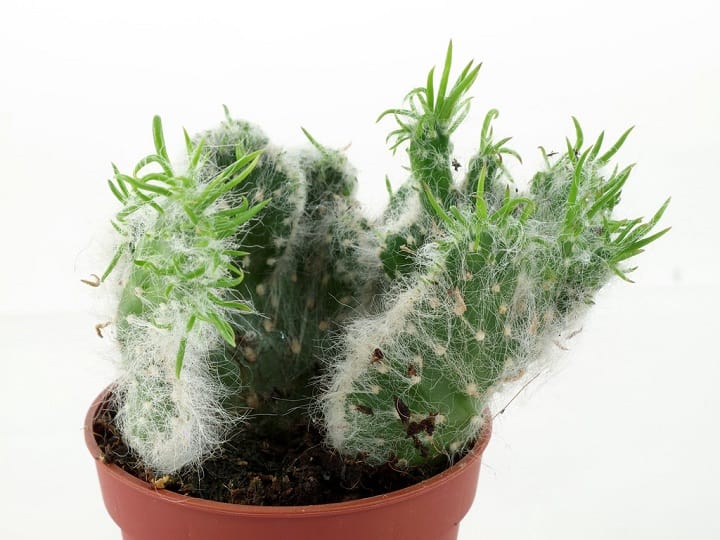
The species name “vestita” refers to the plants’ vestments, its clothing of white hairs that turn into dens colonies of what appear to be patches of snow remembering the high mountain peaks that surround – on all sides – the habitat of this plant.
This particular species needs regular watering when soil is dry during the growing season but it is prone to root rot, so prudent watering is necessary. Keep dry in winter. It comes from high altitude and does not like hot, stuffy summers, so it is best to put them in airy places with ample airflow. It requires a very drained and mineral potting mix and a full sun or slightly shady exposure. Protect from severe frost.
Sources:
https://www.llifle.com/
